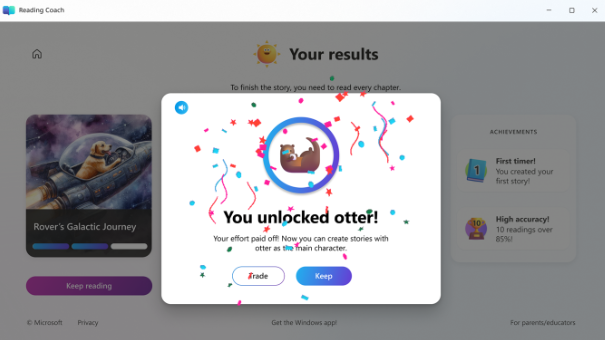Microsoft Reading Coach: How To Teach With The AI Reading Tutor
Teaching tips for Reading Coach, an AI-powered tool designed to teach reading, from the Vice President of Education at Microsoft.

Microsoft’s Reading Coach is one of the new AI teaching tools from Microsoft that is most exciting to Deirdre Quarnstrom, Vice President of Education at Microsoft.
Designed to help new readers over the summer, Microsoft Reading Coach can be accessed by parents and teachers over Teams. Its features include the ability to generate a story on demand, coach students on specific words they might be struggling with, and provide assessments on each students’ overall reading proficiency.
Quarnstrom says the tool is all about providing more personalized instruction to new readers. “We know that when students are more engaged in the reading, and the content is more personalized, and they spend more time, then that becomes a predictor of reading outcomes,” she says.
Keep reading (no pun intended) for everything you need to know about Microsoft’s reading coach.
What Is Microsoft Reading Coach and How Does It Work?
As a new reading tutor from Microsoft, Reading Coach uses cutting-edge generative AI technology to create a personalized reading experience for each student/user. Students can choose a character and a setting for the story, and a reading level at which they want to read. Reading Coach takes it from there.
“We generate a story using AI and then the student reads that, and we use our AI and machine learning algorithms to then provide an assessment of that reading back to the students,” Quarnstrom says.
Using speech-to-text technology, the Reading Coach will evaluate the words a young reader reads aloud and then provide feedback on the accuracy and speed. Students also have the opportunity to continue on with the story they started. “They can choose from a couple of different paths that they could use to create the next passage,” Quarnstrom says.
Tools and ideas to transform education. Sign up below.
Reading Coach works in conjunction with Immersive Reader, Microsoft’s reading tool that allows readers to choose font size and color, and can also read back text to students, supporting accessibility in the process.
Beyond AI, What Are Some Educational Strategies Reading Coach Uses?
Reading Coach incorporates gamification into the learning process to help enhance the AI lessons and drive engagement.
“Students can unlock achievements,” Quarnstrom says. “This is something that I take from my experience with Xbox and Minecraft and game-based learning — when you present a learner something where they have agency in the learning process, and when it's more personalized, more engaging, they spend more time with it.”
How Much Does It Cost?
“It’s available free with a Microsoft account or an Xbox account,” Quarnstrom says.
To start using Reading Coach go to coach.microsoft.com. Click the “start reading” button. Then sign in with your Microsoft account. If this is a personal account, you’ll have access, if you’re using a school account, the school account administrator needs to enable Reading Coach.
What Are Some of Reading Coach’s Best Features?
Some of the Reading Coach features Microsoft recommends include:
- Create AI-generated stories: pick your path through the story chapters, unlock characters and settings to create new stories
- Choose fiction and non-fiction passages from a leveled library
- Read in the fully accessible Immersive Reader that makes reading comfortable for all learners
- Get coaching on challenging words
- Add your own content to read
- Earn badges and see progress
But as with any AI tool, Quarnstrom stresses that Reading Coach is not meant to replace the teacher; instead, all AI tools are designed with the idea of the teacher or parent being thoroughly in control.
“We're focused on empowering educators with these tools, and looking at how we can help save time, help give them back more time to use in the classroom, and also improve their well-being,” she says.
Erik Ofgang is a Tech & Learning contributor. A journalist, author and educator, his work has appeared in The New York Times, the Washington Post, the Smithsonian, The Atlantic, and Associated Press. He currently teaches at Western Connecticut State University’s MFA program. While a staff writer at Connecticut Magazine he won a Society of Professional Journalism Award for his education reporting. He is interested in how humans learn and how technology can make that more effective.

